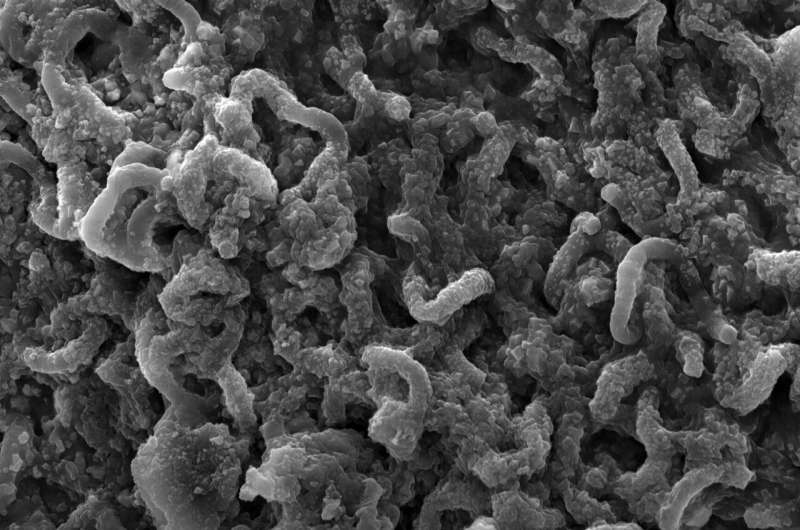This article has been reviewed according to Science X's editorial process and policies. Editors have highlighted the following attributes while ensuring the content's credibility:
fact-checked
trusted source
proofread
Surprising bacterium from Canadian lake shines new light on ancient photosynthesis

Sometimes an experiment doesn't go as planned. That's science. But a "failed" experiment or unexpected results can be the avenue to a discovery you could never anticipate. University of Waterloo Ph.D. student Jackson Tsuji had a poorly growing bacterial sample he wasn't ready to give up on, which ultimately led to a once-in-a-lifetime finding that could change how scientists view photosynthesis and its origins.
In 2015, Tsuji joined professor and University Research Chair Josh Neufeld's lab to hunt for unusual photosynthetic bacteria in northern Canadian lakes. Based on a hypothesis by Earth and Environmental Science professor Sherry Schiff that these lakes might harbor bacteria analogous to those on early Earth, Neufeld, Tsuji and co-op student Nicolette Shaw set out to study Lake 227 at the IISD-Experimental Lakes Area near Kenora, Ontario.
Unfortunately, the team had mixed results in their first two years of lake sampling and cultivation. They didn't manage to grow the bacteria they were looking for, even after hundreds of lake water incubations in glass bottles were exposed to light.
The team went back to the drawing board, but Tsuji kept one of the experiment bottles from Lake 227, because although the sample didn't behave as the team expected, something was happening that he was curious about.
"At the three-month mark, we saw signs that the iron in the bottle was starting to oxidize, even though our main target bacterium was not present in the bottle, which was interesting," Tsuji says. "We tried our best to keep the culture going as a side project and for nearly a year, we kept some culture samples in the back of an incubator and some in the fridge as a backup."
The team's DNA-based tests showed them that a highly unusual bacterium was growing in the bottle, only distantly related to any bacteria that had been grown in a laboratory previously. Because of that, Tsuji took samples from this culture on a research trip to Japan in 2018 to the Photosynthetic Microbial Consortium Laboratory.
The researchers in the Photosynthetic Microbial Consortium Laboratory had experience growing the closest known photosynthetic relatives of the strange bacterium in Tsuji's bottle, and after two months, Tsuji and the research team coaxed the bacterium in the bottle into growing well. They also studied its genome and found something amazing that they hadn't anticipated.
"Certain core photosynthesis genes we had expected to see weren't there, but in their absence, there was a completely novel clade of photosynthetic reaction center protein," Tsuji says. "I remember a professor emeritus in the lab, Keizo Shimada, congratulating me on discovering what we now believe is a new branch of photosynthetic life and a key piece of the puzzle for resolving how photosynthesis developed on Earth. It was surreal."
After his trip, Tsuji returned to Waterloo to complete his Ph.D. and dig deeper into what this discovery could mean.
"This breakthrough challenged current scientific knowledge of how photosynthesis came to be and explained some of the 'whys' we couldn't explain before. Yet, it also created more questions than answers—and I was excited to investigate more," Tsuji says.
When Tsuji completed his Ph.D., Neufeld gave him the samples to continue his work as a postdoctoral researcher at Hokkaido University in Japan.
"This is Jackson's project and I want him to take the lead on next steps," Neufeld says. "His persistence led to an unexpected discovery that could alter perspectives on the origins of photosynthetic life, including plants and algae. It's an exciting time for photosynthesis research, and now that our paper is published, I'm excited to see what will come next for this new research topic in Jackson's laboratory."
Tsuji's postdoctoral work at Hokkaido University, with professor Manabu Fukui and assistant professor Tomohiro Watanabe, enabled the team to gather the key data needed to validate and publish their initial discoveries—the culmination of which is the paper titled "Anoxygenic phototroph of the Chloroflexota uses a Type I reaction center," now published in Nature.
Now, as a young research fellow at the Japan Agency for Marine-Earth Science and Technology, Tsuji continues his research to answer all the questions posed by this bacterium and everything it means for how scientists view the history of photosynthesis. He is currently exploring how the bacterium harvests light and transforms nutrients in its environment, to understand afresh what photosynthetic life on early Earth may have been like.
"Our initial findings for the metabolism of this bacterium and its photosynthetic machinery make it natural to speculate that the bacterium is like a 'living fossil'—an organism that has held onto traits like those of ancient life," Tsuji says. "In the years ahead, we want to learn more about the surprising characteristics of this bacterium to gain new insights into how photosynthesis came to work the way it does today and how this process transformed the Earth throughout its history."
More information: J. M. Tsuji et al, Anoxygenic phototroph of the Chloroflexota uses a type I reaction centre, Nature (2024). DOI: 10.1038/s41586-024-07180-y
Provided by University of Waterloo





















